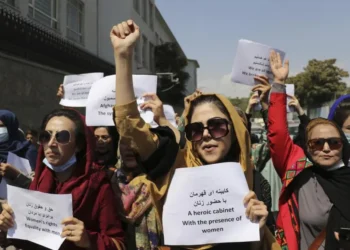Human Lives Human Rights: In the previous two parts, we examined the status of women’s rights before the coalition forces attacked Afghanistan, and in this part, we will examine the period of occupation until the formation of the national government.
With the September 11th attacks and the Taliban being accused as the main perpetrators of this attack, the United States of America, with the decision of the United Nations Security Council, took the leadership of the coalition forces to attack Afghanistan and a large-scale and comprehensive ground and air attack against Afghanistan began, which led to the fall of the Taliban government. There came about many developments in the country and after some time a military government came to work, but the situation of human rights in Afghanistan underwent a drastic change.
After the fall of the Taliban government, schools were reopened. In 2003, the right to education of women and girls was recognized in the new law of this country. Article 44 of the constitution of Afghanistan states: “The state shall devise and implement effective programs to create and foster balanced education for women, improve education of nomads as well as eliminate illiteracy in the country.”
In the field of women’s employment, the principle of equality between men and women in the new constitution of Afghanistan was of great help in improving the employment situation of women in this country after 2001. In 2001, the transitional government of this country allocated $10 million to the Ministry of Women’s Affairs to strengthen the position of women in society, which was the main effort of this ministry to create employment for women.
Now women were in a relatively better position than during the Taliban era. Women made their presence in the parliament and make up about 33% of teachers. The number of female judges reached 240. Women now had presence in the cabinet, some ten women were chosen as deputy ministers and several women as ambassadors.
With the destruction of the first government of the Taliban, women gained the right to vote and be elected according to the country’s constitution, and thus the constitution and the election law clearly stated that at least two women candidates must enter the parliament from among the candidates of each province.
As per this calculation, at least 68 women from 34 provinces of Afghanistan can be present as representatives in the House of Representatives and 23 women in the Senate of Afghanistan. In the Medical and healthcare sector, in Article 52 of the 2003 Constitution of Afghanistan, health considerations for the general public were mentioned as one of the main priorities of the new government. According to this section of the constitution, the government is obliged to provide free facilities for the prevention and treatment of diseases to all citizens, including women. Eventually, it could be seen that the gender view in the constitution regarding the issue of health and treatment in general disappeared, and there was no sign of the law prohibiting women from visiting health centers.
The very important index of life expectancy has increased in recent years and has reached from 56 to 60 years. There has been a significant development in terms of the health of babies and mothers and the reduction of their mortality rates.
Also, with the presence of women in the society without forcing them to cover, their mental health improved significantly compared to the Taliban era.
In 2009, the law prohibiting violence against women was approved in this country. This article is included in Articles 24 and 54 of the Constitution of Afghanistan. This law defines violence against women and states many examples of it states: “Violence is a crime, no one has the right to commit a crime in their residence, government or non-government office, institutions, public places, vehicles or other places. If committed according to the provisions of this law, it is punishable.”


















